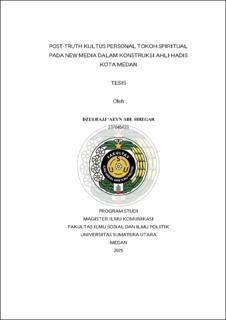| dc.contributor.advisor | Humaizi | |
| dc.contributor.advisor | Pohan, Syafruddin | |
| dc.contributor.author | Siregar, Dzulhajj Aeyn Abe Siregar | |
| dc.date.accessioned | 2025-07-25T03:13:33Z | |
| dc.date.available | 2025-07-25T03:13:33Z | |
| dc.date.issued | 2025 | |
| dc.identifier.citation | Siregar, Dzulhajj (2025). Post-Truth of Spiritual Cult on New Media in The Construction of Medan Hadith Enthusiasts. MEDIAD: Journal of Media and Religion Studies | en_US |
| dc.identifier.uri | https://repositori.usu.ac.id/handle/123456789/107420 | |
| dc.description.abstract | This study analyzes the post-truth phenomenon fostered by three spiritual figures who went viral between 2022 and 2024: Gus Samsudin, Panji Gumilang, and Mama Gufran. These individuals cultivated a culture of personal cult around themselves or their respective institutions to serve specific agendas. Their narratives combined liberal inclusivity with Sufi-styled expressions and god-like claims within the space of New Media, particularly YouTube. One hallmark of personal cults—and of post-truth itself—is the heavy reliance on media. The subjects’ glamorized rhetoric often gave rise to fabricated facts and public controversies that captured the attention of virtual communities. These controversial contents were frequently repackaged by converged media outlets, notably YouTube-based news media such as TV One. This study also examines the authoritative response of government institutions, such as the Ministry of Communication and Informatics (Kominfo/Komidigi), in addressing hoaxes related to religion and myth. Existing regulations—including the Indonesian Ulema Council’s ten criteria for deviant sects, the Information and Electronic Transactions Law (ITE Law), and the anti-sorcery bill—appear to have limited impact. The study incorporates constructive perspectives from hadith scholars in Medan and proposes a framework for identifying hoaxes in the religious and mythological domains by adapting principles from the science of Jarh wa Ta’dil. A constructivist-interpretive paradigm with inductive logic was applied throughout the qualitative methodology. Several interdisciplinary theories were employed, including post-truth theory, personal cult theory, Sufism, transcendental communication, interpersonal deception theory, and Jarh wa Ta’dil. Data were collected and analyzed using Norman Fairclough’s model of Critical Discourse Analysis (CDA) on three TV One news reports. The inclusion of outlier verification in interview sessions further reinforced the CDA findings. The results indicate that initial assumptions regarding the involvement of the subjects in constructing post-truth narratives and personal cults are theoretically robust. The researcher also found that TV One’s position aligns with the public’s dominant stigma. Ultimately, by adapting the science of Jarh wa Ta’dil, the study proposes an instrument for detecting religious and mythological hoaxes, referred to as the Disposisi Jarh wa Ta’dil (DJT). | en_US |
| dc.language.iso | id | en_US |
| dc.publisher | Universitas Sumatera Utara | en_US |
| dc.subject | Post-Truth | en_US |
| dc.subject | Personal Cult | en_US |
| dc.subject | New Media | en_US |
| dc.subject | TV one | en_US |
| dc.subject | Jarh wa Ta'dil | en_US |
| dc.title | Post-Truth Kultus Personal Tokoh Spiritual pada New Media dalam Konstruksi Ahli Hadis Kota Medan | en_US |
| dc.title.alternative | Post-Truth and The Personal Cult of Spiritual Figures in New Media: Constructing Hadith Scholars' Responses in Medan City | en_US |
| dc.type | Thesis | en_US |
| dc.identifier.nim | NIM237045033 | |
| dc.identifier.nidn | NIDN0005125807 | |
| dc.identifier.kodeprodi | KODEPRODI70101#Ilmu Komunikasi | |
| dc.description.pages | 264 Pages | en_US |
| dc.description.type | Tesis Magister | en_US |
| dc.subject.sdgs | SDGs 11. Sustainable Cities And Communities | en_US |


